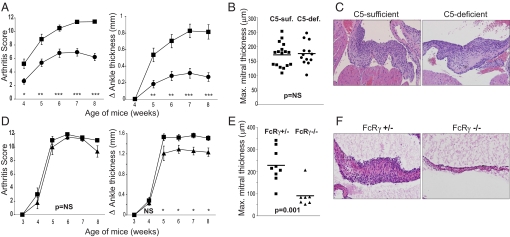Fig. 3.
Differential contributions of C5 and FcRγ to arthritis and endocarditis in K/BxN mice. (A) Arthritis development is impaired in C5-deficient (circles, n = 23) relative to C5-sufficient K/BxN mice (squares, n = 26) as measured by arthritis score and change in ankle thickness as described (29). Error bars, SEM; *, P < 0.05, **, P < 0.001, ***, P < 0.0001. (B and C) Mitral valve inflammation in K/BxN mice is not affected by C5 deficiency as measured by maximum mitral thickness (B) and shown by histology (C). (D) Arthritis scores are equivalent, and only a mild decrement in ankle thickness occurs in FcRγ-deficient (triangles, n = 8) relative to FcRγ-sufficient (squares, n = 10) KRN+ Ag7+ C57BL/6 mice. Error bars, SEM; NS = not significant, *, P < 0.05. (E and F) Mitral valve inflammation is significantly reduced in FcRγ-deficient relative to FcRγ-sufficient mice as measured by maximum mitral thickness (E) and shown by histology (F). For (B) and (E), each point represents one mouse; P values were calculated using Student's t test. (H&E, objective: ×20.)

